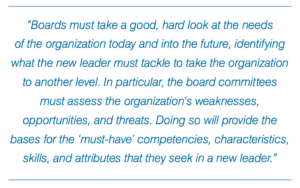Replacing a Longtime, Non-Profit CEO

July 26, 2022 – Many a search firm has encountered the following scene, probably more than once: A frantic board chair or search committee member calls because their esteemed founder and long-tenured leader (LTL) has decided to retire. The organization has no succession plan or otherwise strong internal candidates so they must engage a search firm.
“It is never easy to replace a founder or otherwise LTL,” said BroadView Talent Partners in a new report. “This is typically someone who many consider a legend, a leader with a distinguished career, remarkable body of work and legacy of profound impact. Accordingly, boards of directors must navigate a sometimes unenviable duality that includes exiting the retiring chief executive officer with grace, professionalism, and respect, while partnering with the search firm to recruit the right leader at this stage of the organization’s life cycle. The process requires empathy, inclusivity, transparency, common sense, and foresight.”
Over the years, BroadView Talent Partners has observed that a lack of cohesive succession or transition planning tends to make these situations decidedly more difficult. “Even when an LTL attempts to groom a successor, they don’t always do so in alignment with the board or the organization’s strategic plan,” said the search firm. “Thus, even if an internal candidate emerges at the 11th hour, it is highly unlikely that the internal candidate will be championed by the board.”
While an organization’s search for a new CEO or executive director may prove challenging, opportunity exists, said the search firm, and putting into place a few simple best practices will build the framework for success.
A Window of Opportunity
For starters, organizations must manage the perception that “We’ll never find anyone as great as our LTL.” BroadView Talent Partners says this assertion is nothing more than FEAR – False Evidence Appearing Real – and is absolutely not true. “No one is irreplaceable,” the firm said. “For every CEO search, there is always a cohort of ‘interested and qualified’ candidates. Moreover, in many instances, when you look closely at the last five years of the LTL’s work, you will note a diminishment in overall performance, creativity, and innovation. This natural phenomena opens a window of opportunity, making the case for the change management and strategic vision that a new leader will need to bring.”
Boards must take a good, hard look at the needs of the organization today and into the future, identifying what the new leader must tackle to take the organization to another level. “In particular, the board committees must assess the organization’s weaknesses, opportunities, and threats,” said the search firm. “Doing so will provide the bases for the ‘must-have’ competencies, characteristics, skills, and attributes that they seek in a new leader.”
Being objective, fair, and open minded about the challenges the organization faces is critical. “While it’s okay to be deferential to the legacy, leadership, and accomplishments of the LTL, now is the time to craft a message both internally and externally that a new era of leadership is needed,” said BroadView Talent Partners. “It is the board’s job to make this happen.”
It is also best to avoid creating a new strategic plan within one year of hiring a new CEO. New leaders do not wish to inherit a strategy plan; instead, they should be a part of developing it. “They are excited about their ability to bring a fresh perspective and vision to an organization that has only had an LTL,” said BroadView Talent Partners. “Ultimately, this will invigorate the organization, providing an opportunity for positive change.”

Taking a Back Seat
Before the search is launched, says BroadView Talent Partners, organizations should conduct extensive stakeholder interviews. These include but are not limited to board members and direct reports as well as funders, elected officials, strategic partners, and sponsors.
BroadView Talent Partners also advises against allowing the LTL to be involved in the final decision making and selection process. While it’s understood that LTLs have a vested interest in who will succeed them, they should in no way get to choose the successor or otherwise serve on the search committee, the search firm said. “In fact, the LTL must take a back seat during the search so that candidates can be duly engaged and cultivated,” the firm said. “No candidate wants the LTL to be a visible part of the interview or selection process. However, it is appropriate for the search firm to include the LTL in their stakeholder interviews at the outset of the search, and integrate them into one-on-one meetings with the two finalist candidates. There needs to be a strength of conviction from both the board’s executive and search committees to honor and respect these boundaries.”
Founded in 2015, BroadView Talent Partners is a national executive search firm dedicated to placing leadership in affordable housing agencies, non-profit organizations, and associations, as well as middle market companies. The firm provides clients with a national network, commitment to diversity, equity, and inclusion, and a record of long-tenured placements. Its specialties include executive search, talent acquisition, retention solutions, career management, executive coaching, and board development.











